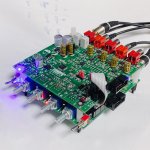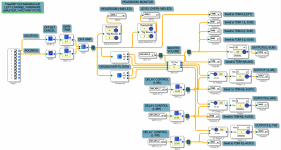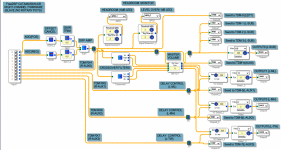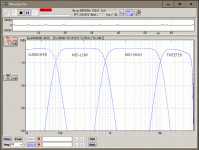Hi,
basically I was searching a good starting point to get a xmos USB working for 32i/32o. Finally found the infinitas and seems the project is almost containing everything I need!
I would now like to use the xmos with the provided firmware (the tdm8 version) for my own private D/A project (only for me; non-commercial). However I do not intend using the FPGA as I can handle TDM streams on my D/A converters. Unfortunately I am not sure about the exact format of the TDM stream provided from the xmos . I cannot find it in the documentation; has anyone a hint for me?
And anyways: great work for the community!!!!
Best regards
Olombo
basically I was searching a good starting point to get a xmos USB working for 32i/32o. Finally found the infinitas and seems the project is almost containing everything I need!
I would now like to use the xmos with the provided firmware (the tdm8 version) for my own private D/A project (only for me; non-commercial). However I do not intend using the FPGA as I can handle TDM streams on my D/A converters. Unfortunately I am not sure about the exact format of the TDM stream provided from the xmos . I cannot find it in the documentation; has anyone a hint for me?
And anyways: great work for the community!!!!
Best regards
Olombo
Why?
Member
Joined 2018
I just commit the repository of the Brand new design "FreeDSP Catamaran A/B"
You can access from this Git-hub page LINK

Note:
This design may work but has not been evaluated yet.
If you build this design, use it at your own risk.
Further discussions at this forum FreeDSP Catamaran A/B thread.
CyberPit
You can access from this Git-hub page LINK
Note:
This design may work but has not been evaluated yet.
If you build this design, use it at your own risk.
Further discussions at this forum FreeDSP Catamaran A/B thread.
CyberPit
https://www.diyaudio.com/community/threads/dsp-board.384999/#post-6990989.I typed in this post that:
Hi guys.
Hi checked a few boards to make an USB audio interface like mchstreamer and freedsp Infinitas. I want to buy an board to convert an audio mixer with 16 audio channel input to an audio mixer with 16 audio channel input. But I think mchstreamer is expensive and freedsp Infinitas is hard to make. Can anyone help me give some alternatives
As always @CyperPit looks great 
I'm working on a prototype/test pcb for a low latency ADAU1772.
Wanting to try it out in Motion feedback Subwoofers.
Problem will be soldering the chip I think ... it's in a 40-Lead Lead Frame Chip Scale Package, and JLCPCB does not have these in stock, so will have to be hand soldered :|

I'm working on a prototype/test pcb for a low latency ADAU1772.
Wanting to try it out in Motion feedback Subwoofers.
Problem will be soldering the chip I think ... it's in a 40-Lead Lead Frame Chip Scale Package, and JLCPCB does not have these in stock, so will have to be hand soldered :|
PS. Anyone have experience with using a LM2596 directly to power the DSP at 3.3 V, without a linear regulator??
Planning to simply use a complete LM2596 module which can be had at almost nothing at e.g. ebay, simply making room for soldering the module onto DSP PCB (e.g. https://www.ebay.com/itm/221920170517 )
.... it will not look as nice as soldering the components directly on the pcb, but this way saves time and cost ...
Planning to simply use a complete LM2596 module which can be had at almost nothing at e.g. ebay, simply making room for soldering the module onto DSP PCB (e.g. https://www.ebay.com/itm/221920170517 )
.... it will not look as nice as soldering the components directly on the pcb, but this way saves time and cost ...
Member
Joined 2018
Hi
Today I released the design information for FreeDSP Catamaran A/B. Board Production Information and 4way stereo channel divider example code are also provided in the FreeDSP Git-Hub repository.
[FreeDSP Catamaran A/B Git-hub]
https://github.com/freeDSP/FreeDSP_Catamaran_AB
[FreeDSP Catamaran A/B DIYAudio Forum Thread]
https://www.diyaudio.com/community/threads/freedsp-catamaran-a-b.381417/
Enjoy your DIY Audio life!
CyberPit
Today I released the design information for FreeDSP Catamaran A/B. Board Production Information and 4way stereo channel divider example code are also provided in the FreeDSP Git-Hub repository.
[FreeDSP Catamaran A/B Git-hub]
https://github.com/freeDSP/FreeDSP_Catamaran_AB
[FreeDSP Catamaran A/B DIYAudio Forum Thread]
https://www.diyaudio.com/community/threads/freedsp-catamaran-a-b.381417/
Enjoy your DIY Audio life!
CyberPit
Attachments
Member
Joined 2018
Hello, DIY volks,
I updated the FreeDSP Catamatan A/B board and schematic design. A
 new Version 1.2 feature is automatic DSP firmware reload on the transition of A/B program switching. The reset button is not required anymore!
new Version 1.2 feature is automatic DSP firmware reload on the transition of A/B program switching. The reset button is not required anymore!
JLPCB's PCBA information is also updated.
[FreeDSP Project Git-Hub LINK]
https://github.com/freeDSP/FreeDSP_Catamaran_AB
Designing Pleasure
CyberPit
I updated the FreeDSP Catamatan A/B board and schematic design. A
JLPCB's PCBA information is also updated.
[FreeDSP Project Git-Hub LINK]
https://github.com/freeDSP/FreeDSP_Catamaran_AB
Designing Pleasure
CyberPit
Hello everyone,
over the past few months, I was looking for a DSP board/chip for an integrated Speaker build and did a lot of reading and PCB Design based on the freeDSP project and the related ADAU chips. Due to the chip shortage, a lot of the builds had issues sourcing the parts for the builds, including myself. Therefore, I started to look for options for designing a DSP.
So here`s the question: Have you considered using a different chip? And if so, could a board without an ADAU chip still be called FreeDSP?
My speaker is currently driven by Sure JAB's and programmed with SigmaDSP and I had in mind replacing them with custom build amps and USB-DSP's with streaming capabilities, but for my needs, I would have to integrate a lot of other MCUs if I choose to use an ADAU IC. Lacking ethernet and USB 2.0 connectivity, programming via proprietary IDE using a programmer board feels just a bit old-fashioned to me.
I had the intention to contribute to freeDSP and share my board design, but I'm not sure if that's the right place if the board design is too different. I already have some ideas in mind and I would love to contribute to a fantastic community project.
Best Fabian
over the past few months, I was looking for a DSP board/chip for an integrated Speaker build and did a lot of reading and PCB Design based on the freeDSP project and the related ADAU chips. Due to the chip shortage, a lot of the builds had issues sourcing the parts for the builds, including myself. Therefore, I started to look for options for designing a DSP.
So here`s the question: Have you considered using a different chip? And if so, could a board without an ADAU chip still be called FreeDSP?
My speaker is currently driven by Sure JAB's and programmed with SigmaDSP and I had in mind replacing them with custom build amps and USB-DSP's with streaming capabilities, but for my needs, I would have to integrate a lot of other MCUs if I choose to use an ADAU IC. Lacking ethernet and USB 2.0 connectivity, programming via proprietary IDE using a programmer board feels just a bit old-fashioned to me.
I had the intention to contribute to freeDSP and share my board design, but I'm not sure if that's the right place if the board design is too different. I already have some ideas in mind and I would love to contribute to a fantastic community project.
Best Fabian
Yes the chip shortage is a bitch :|
I think the trick here wit e.g. FreeDSP is the use of the super easy SigmaStudio tool.
For me this is why I use ADAU chips.
As far as I can see there is more then 900 chips in stock at Mouser https://www.mouser.dk/ProductDetail/Analog-Devices/ADAU1701JSTZ-RL?qs=BpaRKvA4VqFZC2AGaYivag==
The price has of course increased ... but that is how it works in a shortage
To get familiar wit the whole concept I started with a finished board from Wondom
https://www.audiophonics.fr/en/dsp-...al-signal-processor-kernel-board-p-11212.html
and a programmer also from Wondom https://www.audiophonics.fr/en/dsp-...io-programmer-board-for-sure-dsp-p-12245.html
I still use the programmer for all my boards, but the dsp board was just a tester (I also had the I/O board). I can recommend this as a first step, thereafter it's easy to do your own boards.
But for me SigmaStudio is the way to go
I think the trick here wit e.g. FreeDSP is the use of the super easy SigmaStudio tool.
For me this is why I use ADAU chips.
As far as I can see there is more then 900 chips in stock at Mouser https://www.mouser.dk/ProductDetail/Analog-Devices/ADAU1701JSTZ-RL?qs=BpaRKvA4VqFZC2AGaYivag==
The price has of course increased ... but that is how it works in a shortage
To get familiar wit the whole concept I started with a finished board from Wondom
https://www.audiophonics.fr/en/dsp-...al-signal-processor-kernel-board-p-11212.html
and a programmer also from Wondom https://www.audiophonics.fr/en/dsp-...io-programmer-board-for-sure-dsp-p-12245.html
I still use the programmer for all my boards, but the dsp board was just a tester (I also had the I/O board). I can recommend this as a first step, thereafter it's easy to do your own boards.
But for me SigmaStudio is the way to go
Hey @Baldin,
I pretty much followed the path you described, getting familiar with the Wondom boards and programming the DSP. Looking at the Hifi market, a lot of new active speakers are basically "fully integrated amplified streaming DACs", I don't have a better description for it... And I'm not talking about Smarthome speakers and soundbars. My feeling tells me that this is the direction the industry is heading. For the DIY enthusiast that is not seeking that absolute premium, there are a lot of "good-enough" options out there, ranging from prebuild Wondoms to boards like the Aurora. But a lot can be done with MCUs nowadays that hasn't been possible years ago.
Right now I'm looking toward the NXP RT600, which is a Cortex M33 + a Hifi4 MCU/IC combination that solves some problems with integration, most importantly the USB 2.0 High-Speed compatability, making programming very easy. For testing, I got a teensy 4.1 (it uses an NXP chip from the same family) and got bidirectional USB streaming and amplification over I2S working in less than a day.
The problem I see with this kind of MCU is, that they normally come in smaller packages and most of them are BGA, making hand-soldering way harder. I did some QFN64, but that's already nearly impossible without proper equipment. But with PCB companies offering assembly for a reasonable price this isn't a big issue anymore.
The question is if the freeDSP community is interested in looking toward other hard and software options while keeping the concept of open source DSP that is low cost and easy to build in mind.
Best, Fabian
I pretty much followed the path you described, getting familiar with the Wondom boards and programming the DSP. Looking at the Hifi market, a lot of new active speakers are basically "fully integrated amplified streaming DACs", I don't have a better description for it... And I'm not talking about Smarthome speakers and soundbars. My feeling tells me that this is the direction the industry is heading. For the DIY enthusiast that is not seeking that absolute premium, there are a lot of "good-enough" options out there, ranging from prebuild Wondoms to boards like the Aurora. But a lot can be done with MCUs nowadays that hasn't been possible years ago.
Right now I'm looking toward the NXP RT600, which is a Cortex M33 + a Hifi4 MCU/IC combination that solves some problems with integration, most importantly the USB 2.0 High-Speed compatability, making programming very easy. For testing, I got a teensy 4.1 (it uses an NXP chip from the same family) and got bidirectional USB streaming and amplification over I2S working in less than a day.
The problem I see with this kind of MCU is, that they normally come in smaller packages and most of them are BGA, making hand-soldering way harder. I did some QFN64, but that's already nearly impossible without proper equipment. But with PCB companies offering assembly for a reasonable price this isn't a big issue anymore.
The question is if the freeDSP community is interested in looking toward other hard and software options while keeping the concept of open source DSP that is low cost and easy to build in mind.
Best, Fabian
I am looking for a DSP board with a SPDIF input and a SPDIF output (I will use own DACs after, if this DSP section works).
I have seen on the post #1 that there are some freeDSP IO expansions, such as:
- freeDSPx AES/SPDIF IN (1 x In AES/EBU via XLR / 1 x In SPDIF via RCA)
-and the freeDSPx SPDIF IO (1 x In & 1 x Out SPDIF via RCA & Toslink).
Consequently the FreeDSP CLASSIC SMD A/B board would be enough for me if I can get these Expansion boards.
Do you know if they are available somewhere, preferably in Europe ?
or if both the Gerber file and the complete List of Parts are available in order to assemble them by myself ? To date, I have found the Gerber files (for the All in One board) but not the complete list of parts ....
Thank you very much
I have seen on the post #1 that there are some freeDSP IO expansions, such as:
- freeDSPx AES/SPDIF IN (1 x In AES/EBU via XLR / 1 x In SPDIF via RCA)
-and the freeDSPx SPDIF IO (1 x In & 1 x Out SPDIF via RCA & Toslink).
Consequently the FreeDSP CLASSIC SMD A/B board would be enough for me if I can get these Expansion boards.
Do you know if they are available somewhere, preferably in Europe ?
or if both the Gerber file and the complete List of Parts are available in order to assemble them by myself ? To date, I have found the Gerber files (for the All in One board) but not the complete list of parts ....
Thank you very much
Sorry for my previous post: I have found the info on Github...I am looking for a DSP board with a SPDIF input and a SPDIF output (I will use own DACs after, if this DSP section works).
I have seen on the post #1 that there are some freeDSP IO expansions, such as:
- freeDSPx AES/SPDIF IN (1 x In AES/EBU via XLR / 1 x In SPDIF via RCA)
-and the freeDSPx SPDIF IO (1 x In & 1 x Out SPDIF via RCA & Toslink).
Consequently the FreeDSP CLASSIC SMD A/B board would be enough for me if I can get these Expansion boards.
Do you know if they are available somewhere, preferably in Europe ?
or if both the Gerber file and the complete List of Parts are available in order to assemble them by myself ? To date, I have found the Gerber files (for the All in One board) but not the complete list of parts ....
Thank you very much
I can't edit my previous post for an unknown reason, so I post this reply
Thank you
I published a groupbuy for freedsp expansion board already assembled. I f anyone want participate the lik is https://www.diyaudio.com/community/...8-components-pcb-factory-and-assembly.391676/
Hi! Complete newbie here who just discovered https://freedsp.github.io/. I have some questions I was hoping perhaps to find answers to here:
Thank you and sorry if the questions are a little basic :-}
- Are any of the boards at your website buyable at the moment? Or, in order to just get into the topic, can one also buy something like this? https://www.ebay.de/itm/222926596780
- The website shows a screenshot of a software for programming DSP chips. Googling the image, I think it is "SigmaStudio", which looks very complicated. Is there also something a little simpler with not as many possibilities?
- Do I understand correctly that a DSP could (for example) be put on a laptop's AUX output on one end and into an amplifier's AUX input on the other and then act as many different things (for example an equalizer)?
- Finally, is a DSP also what is used by companies such as Sonos? Perhaps together with a microphone or something to "listen" to what the room the speaker is standing in "sounds" like?
Thank you and sorry if the questions are a little basic :-}
Member
Joined 2018
Hi sixtyfive-San,
I can answer some of your questions...
In SigmaStudio, you can program Multiband Compressor, Dynamic Loudness, Sub-Harmonic Bass, Automatic Level Control, 48dB/oct Crossover, Delay, etc... for creating your own sound very easily.
Also, the SigmaDSP can handle four PDM microphones. So you can create beam-forming firmware but maybe needs some additional processors to identify the incoming sound direction.
CyberPit
I can answer some of your questions...
Basically "NO". Because it's a DIY'er community product. But some of them are available from personal distributors. If you want to know the detail of each design, you can access the FreeDSP GitHub .Are any of the boards at your website buyable at the moment? Or, in order to just get into the topic, can one also buy something like this?
It's easy, Clone the GItHub project on your PC, then write the firmware to the board via SigmaStudio. No source code text typing is required.The website shows a screenshot of a software for programming DSP chips. Googling the image, I think it is "SigmaStudio", which looks very complicated. Is there also something a little simpler with not as many possibilities?
There are two kinds of chips used. One is ADAU1701 and the other is ADAU1452/1466. ADAU1701 has embedded audio 2ch ADC and 4ch DAC and I8S interface. Embedded 20bit ADC & DAC's quality is good enough for most casual audio applications. Especially my design FreeDSP Catamaran A/B is focused on the performance of embedded ADC. It's ADC through DAC overall 750Hz distortion performance equals 0.00075%. ADAU1452 does not have audio codecs but it has S/PDIF I/O, SRC, and 4 times I2S Input and output.Do I understand correctly that a DSP could (for example) be put on a laptop's AUX output on one end and into an amplifier's AUX input on the other and then act as many different things (for example an equalizer)?
The early products of Sonos are not using DSP, perhaps their processed audio signals are in the PowerPC processor.Finally, is a DSP also what is used by companies such as Sonos? Perhaps together with a microphone or something to "listen" to what the room the speaker is standing in "sounds" like?
In SigmaStudio, you can program Multiband Compressor, Dynamic Loudness, Sub-Harmonic Bass, Automatic Level Control, 48dB/oct Crossover, Delay, etc... for creating your own sound very easily.
Also, the SigmaDSP can handle four PDM microphones. So you can create beam-forming firmware but maybe needs some additional processors to identify the incoming sound direction.
CyberPit
- Home
- Source & Line
- Digital Line Level
- freeDSP main thread



